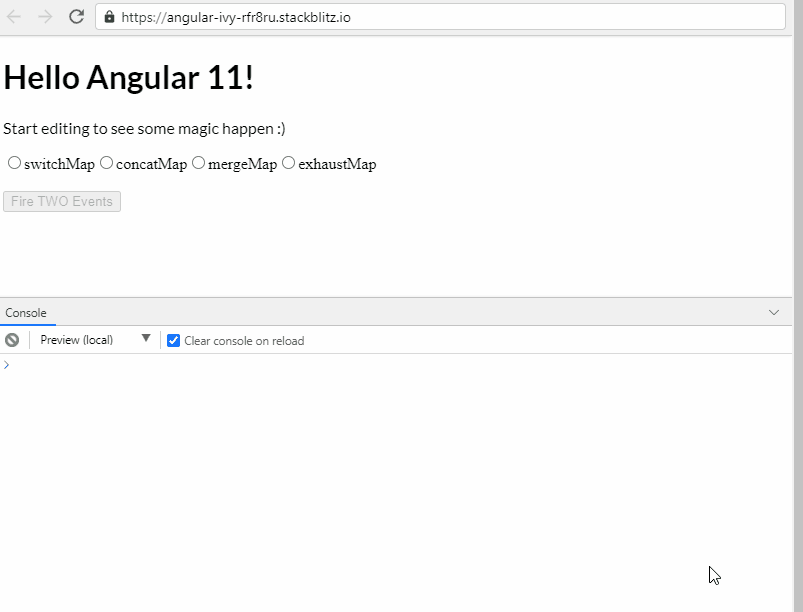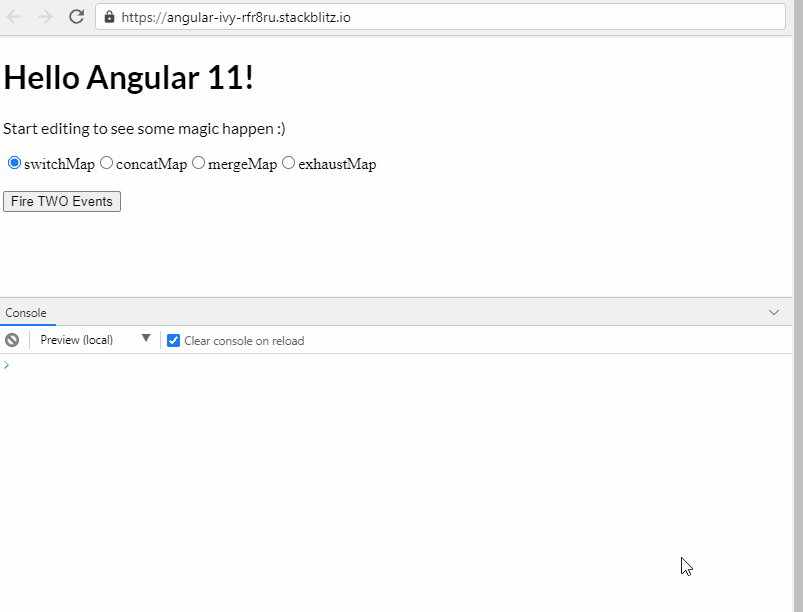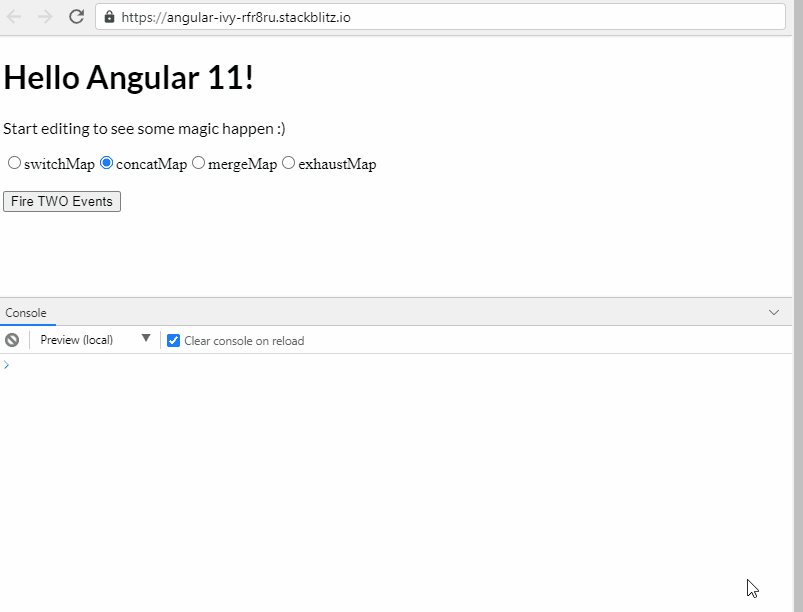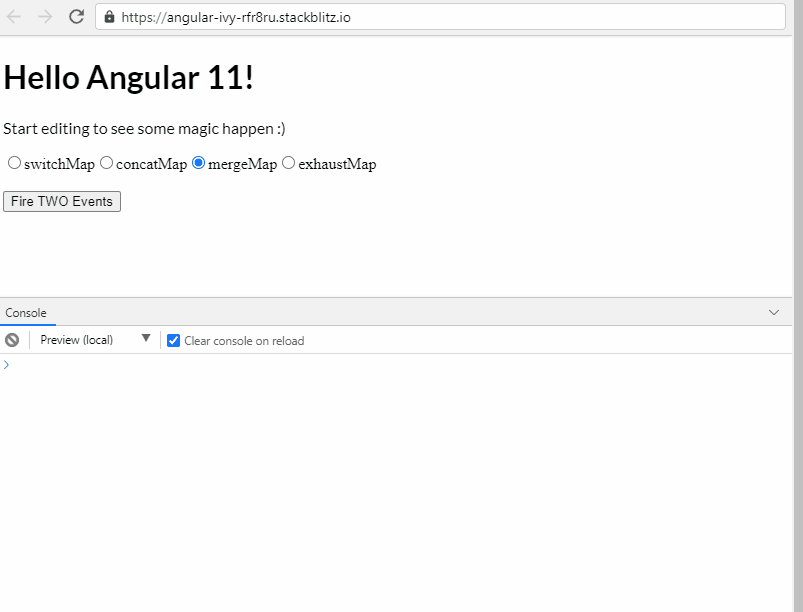SwitchMap, MergeMap, ConcatMap & ExhaustMap Explained
SwitchMap, MergeMap, ConcatMap & ExhaustMap Explained
With this article I want to describe the differences between the rxjs operators switchMap, mergeMap, concatMap and exhaustMap.
Table of content
The last article tap, map & switchMap explained is, depending on the stats, one of my most successful blogs ever. So I thought I could continue writing something about rxjs and the operators mentioned above.
As mentioned in tap, map & switchMap explained:
There are many blog posts out there which cover those topics already but maybe this helps to understand if the other posts did not help until here :)
The operators switchMap, mergeMap, concatMap and exhaustMap do not show any difference at first sight when they are called one time. They take a value, proceed it and return back a new observable.
The operators differ in how they treat values in an observable when multiple values get emitted right after each other. Maybe this is one of the most important things to understand. Observables give you the possibility to handle “values over time”. So when the first value gets emitted, the second one, the third one etc. right after each other the switchMap, mergeMap, concatMap and exhaustMap behave differently.
Let us take a look at the behavior of those operators in specific next.
Stackblitz
https://stackblitz.com/edit/angular-ivy-rfr8ru
The situation
First let us imagine we have a long running operation like an HTTP call and after an amount of time the result comes back. We use a method which creates an observable and after two seconds it returns the value we pass in the function for the sake of simplicity and to simulate a long running task.
anyLongRunningOp(value: string) {
return timer(2000).pipe(mapTo(value));
}
This method does nothing but wait for two seconds and then return a value. Could be an HTTP call in the real world or something else asynchronous which takes a little bit of time.
Using this method would be like
// ...
anyLongRunningOp('value').subscribe((result) => {
// after two seconds we get our subscribe called
console.log(result); // <<<< logs 'value'
});
To explain switchMap, mergeMap, concatMap and exhaustMap let us always assume that we call the method anyLongRunningOp multiple times! This is important. So we call it and immediately call the method again but the first call has not completed (hence the 2 seconds delay).
To be able to emit multiple observables we can create a Subject where we can write values in with next(...) and process it with the operator we want to take a look at.
const sub = new Subject<string>();
fireEvents() {
// Here we react ot everything which is fired in the subject
this.sub
.asObservable()
// Here we can take the operator we want to take a look at which returns the
// result from the anyLongRunningOp method which is the value itself
// (for the sake of simplicity). The `tap` only prints out what
// was just sent, does nothing to the stream!
.pipe(
tap(value => console.log("--> sent out", value)),
[OPERATOR_HERE]((value) => this.anyLongRunningOp(value)))
// We console.log the output, which is 'first' or 'second' or
.subscribe(value => console.log("<-- received", value));
// After subscribing we emit the two value in the observable, could also be more than that
this.sub.next('first');
this.sub.next('second');
console.log("-------");
}
anyLongRunningOp(value: string) {
return timer(2000).pipe(mapTo(value));
}
The fireEvents() method emits in the Subject sub two times one value each. First the value first and immediately after the value second. This value then gets processed by the operator we want to look how it behaves when multiple values come in.
SwitchMap
Let us take a look at the switchMap (docs) operator first. I explained it already in the previous post but let us take it as the first one and look how it behaves when multiple values come in.
fireEvents() {
// Here we react ot everything which is fired in the subject
this.sub
.asObservable()
// Here we can take the operator we want to take a look at which returns the
// result from the anyLongRunningOp method which is the value itself
// (for the sake of simplicity). The `tap` only prints out what
// was just sent, does nothing to the stream!
.pipe(
tap(value => console.log("--> sent out", value)),
switchMap(value => this.anyLongRunningOp(value))
)
// We console.log the output, which is 'first' or 'second' or
.subscribe(value => console.log("<-- received", value));
// After subscribing we emit the two value in the observable, could also be more than that
this.sub.next("first");
this.sub.next("second");
console.log("-------");
}
The switchMap operator takes the first value in the stream first and calls the anyLongRunningOp with it. Right after it did this it receives the second emit with the value second. Now it forgets about the response of the first request. It is not waiting for it. It calls the anyLongRunningOp with the second parameter and waits for that one’s answer. And so with multiple ones, it is only interested in the response of the last one it fired. Everything before got ignored.

In the animation you can see that only the value second is printed. This is the last one which got fired. The first response is ignored by the switchMap operator when a second one comes in and the first one is not finished yet.
ConcatMap
Next one in the list is the concatMap (docs) operator. Let us assume the same method again:
fireEvents() {
// Here we react ot everything which is fired in the subject
this.sub
.asObservable()
// Here we can take the operator we want to take a look at which returns the
// result from the anyLongRunningOp method which is the value itself
// (for the sake of simplicity). The `tap` only prints out what
// was just sent, does nothing to the stream!
.pipe(
tap(value => console.log("--> sent out", value)),
concatMap(value => this.anyLongRunningOp(value))
)
// We console.log the output, which is 'first' or 'second' or
.subscribe(value => console.log("<-- received", value));
// After subscribing we emit the two value in the observable, could also be more than that
this.sub.next("first");
this.sub.next("second");
console.log("-------");
}
We know that the switchMap operator is only interested in the most recent value which came in. It does not build a relation between everything which comes in and puts them in a queue. This is what the concatMap operator is for. It has a queue and stores the incoming calls and emits the next one when the previous one came back! So when it receives the value with first it calls anyLongRunningOp with first, then the second value comes in. The concatMap operator now holds this call back until the anyLongRunningOp method comes back with the result of the call with first and then the next call with second as parameter is being fired. It concatenates the calls and emits them one after another. As a side effect it builds a relation between the calls because it has to look wether the first one came back before it can emit the next one.

In the animation you can see that first and second got emitted and after two seconds the first call comes back and after another two seconds the second call comes back. concatMap here queues the requests and emits them when the previous one has finished.
MergeMap
Let us take the mergeMap (docs) operator next. Again we are trying to see how it behaves if multiple values come in when the previous one does not have come back yet.
fireEvents() {
// Here we react ot everything which is fired in the subject
this.sub
.asObservable()
// Here we can take the operator we want to take a look at which returns the
// result from the anyLongRunningOp method which is the value itself
// (for the sake of simplicity). The `tap` only prints out what
// was just sent, does nothing to the stream!
.pipe(
tap(value => console.log("--> sent out", value)),
mergeMap(value => this.anyLongRunningOp(value))
)
// We console.log the output, which is 'first' or 'second' or
.subscribe(value => console.log("<-- received", value));
// After subscribing we emit the two value in the observable, could also be more than that
this.sub.next('first');
this.sub.next('second');
console.log(`fired events 'first' and 'second'`);
}
The mergeMap (docs) operator does not ignore the result of the previous emits and does not wait for the second one to emit until the first one finished. It emits both calls as they come in. So if we emit first the operator calls the anyLongRunningOp with first and right after that it calls the anyLongRunningOp with second. It also listens to both answers when they come back. When the anyLongRunningOp method comes back the first time with first we print out that result and right after this with second we print out this. These operations run in parallel. The operator does not build a relation between these two calls. The first one which comes back gets processed first, the second one which comes back gets processed second. So the order of the return values is not guaranteed to be the order of the requests as they were sent out.

In the animation you can see that both values first and second get emitted and they come back almost at the same time. mergeMap emits them as they come in, both need two seconds to be processed and come back then. The operator mergeMap does not wait for the first one to complete (like concatMap) and nothing gets ignored (like switchMap).
ExhaustMap
Then there is the exhaustMap (docs) operator left.
fireEvents() {
// Here we react ot everything which is fired in the subject
this.sub
.asObservable()
// Here we can take the operator we want to take a look at which returns the
// result from the anyLongRunningOp method which is the value itself
// (for the sake of simplicity). The `tap` only prints out what
// was just sent, does nothing to the stream!
.pipe(
tap(value => console.log("--> sent out", value)),
exhaustMap(value => this.anyLongRunningOp(value))
)
// We console.log the output, which is 'first' or 'second' or
.subscribe(value => console.log("<-- received", value));
// After subscribing we emit the two value in the observable, could also be more than that
this.sub.next('first');
this.sub.next('second');
console.log(`fired events 'first' and 'second'`);
}
The exhaustMap operator takes care of the first request which comes in and ignores everything which comes in afterwards until the first one came back. So it is called with the value first and then with the value second which is ignored because the first one has not completed yet. So it ignores everything until the first value comes back.

In the animation you can see it gets emitted with first and second but only the first emission is being processed. The exhaustMap ignored everything which comes after this until the first call came back after two seconds. Then it is ready to process the next value when it gets emitted again. Everything during the procedure of the first call gets ignored. So only the value first is printed in the example.
Summary
It took me along while to understand those operators and for me it all became clearer when I understood the switchMap operator first.
Let us summarize those four operators:
switchMap: emits values and is only interested in the very last one it sent. All the responses of the calls before get ignored.concatMap: behaves like a queue: It stores all calls and sends one after another. If one is completed, the next one is being processed.mergeMap: Also sends all requests, likeconcatMapbut does not wait until the response is coming back. It sends them out as they come. But it receives every response and does not ignore something. The order here is not guaranteed.exhaustMap: Emits the first request and ignores all future requests until the first one gets back. Then it is ready for a new one.
I hope this helped!
Helpful Links
Thanks.
Fabian









